I'm finally getting around to posting all the pictures of this. It actually turned out pretty good, even though I was too impatient to wait to order some more fitting parts from online. Oddly enough, I could find almost all the parts locally besides these tiny little brackets that were basically holders to create a patch panel out of already plumbed out keystones.
After having my network completely reset itself a couple times, sometimes randomly, sometimes during a storm, sometimes during something normal spiking the electrical in the house like a washer or vacuum being turned on, I decided something needed to be done. The "home connectivity center" that was installed by the company I had wire my house up was a generic piece of crap that had a cover that was almost impossible to line up and put back in its place properly.
I was thinking I would get a connectivity box with a door. Nope.
Anyway, my thoughts were to find a UPS and get the central D-Link 5 port gigabit switch on it, something with voltage regulation hopefully, but at least something that should provide uninterrupted power should the power spike up or down. Simple, right? Not so much.
The box did not provide enough room, I would have had to special order some funky UPS from online, and I still wasn't guaranteed it was the best solution. It would radiate some heat and the box already made me a bit nervous heat-wise.
After talking to my old boss he got me thinking again about putting the UPS somewhere else. I realized I had the perfect place to put it - the access panel to my jetted tub right below the box (I figured that's where they ran the power from to power the box anyway...)
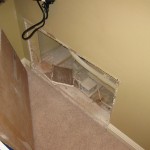
Anyway, here's the box before (a little messy, I did have the FiOS router strapped in too, just didn't take pics first)

With the smallest UPS I could find, which actually might have worked but definately would have been a heat worry...
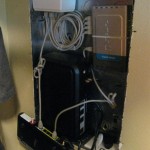
I called around to look for a different box, that may be deeper or at least had an easier cover to put on. Sadly, I could only find one. It did not match up with mine either. Mine was 20" tall, the standard height seems to be 28" for a medium size one. So I decided I would rip mine out and replace it, and actually cut out 8 inches of my wall (what the hell was I thinking?)
I went and picked up the "home connection center" at Home Depot, and decided to get to work. What annoyed me is they only sold two other accessories for this unit, one of them was $50 just for a couple internal attachments. No thanks. I'll figure that out later.
Now the old one is ripped out of the wall:
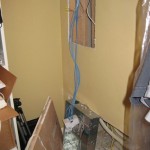
What the bottom looked like after I cleaned it up a little:
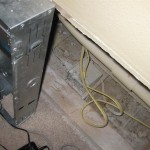
Oh yeah - this is what I was given. They plumbed it out for me nicely, so I just needed to find a little patch panel type thing - should be easy enough (so I thought...)
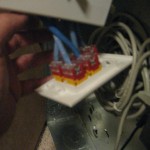
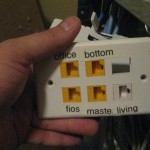
Skip forward after sawing out my wall (I did a hell of a good job for the tools I had available to me, I think!)
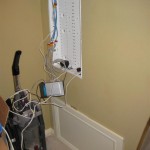
Now, time to lay out the internal components. They've got some bracket accessories, but of course nobody had any at 12am at night, not to mention it didn't look good that any place would have it in stock locally to begin with.
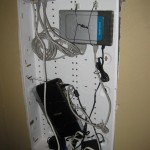
Cleaned up a little bit more:
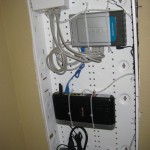
Finally, this will be about as good as I can get it. You'll note that I used zip ties - those were fun to fish around behind the panel (I'm joking) and the left side has a normal wall plate with 6 keystone spaces. I rigged it in to one of the only brackets any company had in town.
You'll see in the middle picture at the bottom the power cables. I bought an extension cable and split it myself to power my own power outlet that was wired directly to the UPS underneath the box, so the entire power outlet could be considered UPS'ed. The power cable on the rightmost is actually the original power cable - I was able to retain that. So it winds up being
Original power cable -> UPS -> New power outlets -> Router and Switch
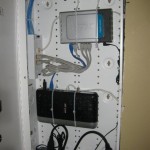
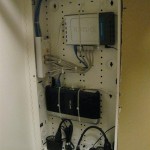
When I looked in the little diagram I realized that there was an optional door that could be added. Instantly I got even more excited about the outcome of this project. I was finally going to have a box with a door. I was actually happy with the original hinged cover it came with, it was much easier to use than the old panel. That one was a piece of garbage.
Anyway, the final product, with the door...
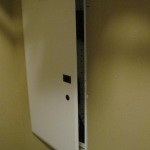
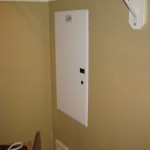
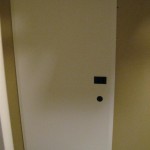
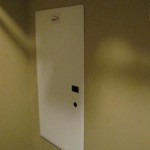
Oh, and of course, the UPS that is underneath all of this:

I propped it up on some of the original foam packaging to keep it off the dusty/dirty/possibly wet ground (some day) - seems to have worked out quite well. I did clean up the cords a bit more too though.
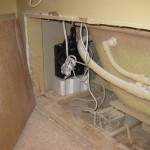
Now all I need is to clean up the paint job. They had painted with the access door to the tub on, so when I went to remove it, it ripped off dried paint. That was a nice surprise. Also, there's some marks on the walls from random stuff and a sharpee mark from where the old box lined up. But when it's all sealed you can't really see any of that.
All in all, I'm kinda happy. Being such an Internet geek, I have very little patience for any manual labor, so to complete a project and for it to come together so well with a mish-mash of parts and tools was neat. I got the majority of work done the first night, but wound up bleeding in to the second day when I was trying to track down the other spare parts. Couldn't find the patch panel-ish thing (they do make one, but I would have had to wait 2-3 days at least) - so I just crafted some thing on that left side that works just as well.
It's functional, clean, has more space than it did before, has a door and now is fully UPS-ized. All in all, it was a good experience.

















